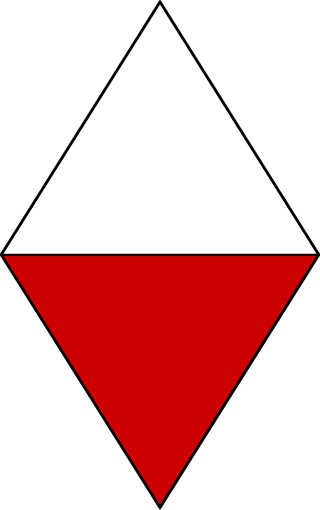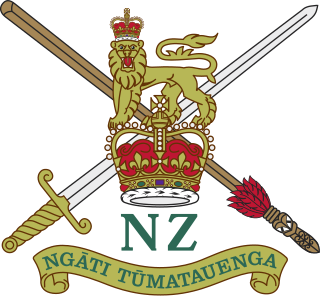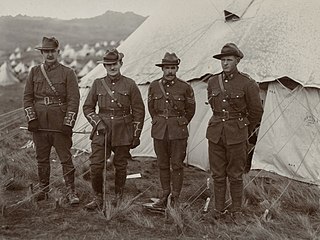
The 11th (Northern) Division, was an infantry division of the British Army during the First World War, raised from men who had volunteered for Lord Kitchener's New Armies. The division fought in the Gallipoli Campaign and on the Western Front. The division's insignia was an ankh or ankhus.

Australian Light Horse were mounted troops with characteristics of both cavalry and mounted infantry, who served in the Second Boer War and World War I. During the inter-war years, a number of regiments were raised as part of Australia's part-time military force. These units were gradually mechanised either before or during World War II, although only a small number undertook operational service during the war. A number of Australian light horse units are still in existence today.

The 42nd Infantry Division was an infantry division of the British Army. The division was raised in 1908 as part of the Territorial Force (TF), originally as the East Lancashire Division, and was redesignated as the 42nd Division on 25 May 1915. It was the first TF division to be sent overseas during the First World War. The division fought at Gallipoli, in the Sinai desert and on the Western Front in France and Belgium. Disbanded after the war, it was reformed in the Territorial Army (TA), in the Second World War it served as the 42nd Infantry Division with the British Expeditionary Force (BEF) and fought in Belgium and France before being evacuated at Dunkirk. The division was later reformed in the United Kingdom and, in November 1941, was converted into the 42nd Armoured Division, which was disbanded in October 1943 without serving overseas. A 2nd Line duplicate formation, the 66th Infantry Division, was created when the Territorials were doubled in both world wars.
The Australian Mounted Division originally formed as the Imperial Mounted Division in January 1917, was a mounted infantry, light horse and yeomanry division. The division was formed in Egypt, and along with the Anzac Mounted Division formed part of Desert Column, Egyptian Expeditionary Force in World War I. The division was originally made up of the Australian 3rd Light Horse Brigade, the reconstituted 4th Light Horse Brigade, and two British yeomanry brigades; the 5th Mounted Brigade and 6th Mounted Brigade.

The New Zealand Expeditionary Force (NZEF) was the title of the military forces sent from New Zealand to fight alongside other British Empire and Dominion troops during World War I (1914–1918) and World War II (1939–1945). Ultimately, the NZEF of World War I became known as the First New Zealand Expeditionary Force. The NZEF of World War II was known as the Second New Zealand Expeditionary Force (2NZEF).

The New Zealand Mounted Rifles Brigade was a brigade of the New Zealand Army during the First World War. Raised in 1914 as part of the New Zealand Expeditionary Force, it was one of the first New Zealand units to sail for service overseas.

The Cameronians (Scottish Rifles) was a rifle regiment of the British Army, the only regiment of rifles amongst the Scottish regiments of infantry. It was formed in 1881 under the Childers Reforms by the amalgamation of the 26th Cameronian Regiment and the 90th Perthshire Light Infantry. In 1968, when reductions were required, the regiment chose to be disbanded rather than amalgamated with another regiment, one of only two infantry regiments in the British Army to do so, with the other being the York and Lancaster Regiment. It can trace its roots to that of the Cameronians, later the 26th of Foot, who were raised in 1689. The 1881 amalgamation coincided with the Cameronian's selection to become the new Scottish Rifles.

The Otago Infantry Regiment was a military unit that served within the New Zealand Expeditionary Force (NZEF) in World War I during the Gallipoli Campaign (1915) and on the Western Front (1916–1919). This Regiment and the Otago Mounted Rifles Regiment were composed mostly of men from Otago and Southland. The Otago Infantry Regiment represented the continuation of the Dunedin and Invercargill Militia Battalions formed in 1860.
The Royal East Kent Yeomanry was a British Army regiment formed in 1794. It saw action in the Second Boer War and the First World War.

The Queen's Own West Kent Yeomanry was a British Army regiment formed in 1794. It served in the Second Boer War and the First World War. It amalgamated with the Royal East Kent Yeomanry to form the Kent Yeomanry in 1920.
The 5th Mounted Rifles was formed on 17 March 1911. It formed part of the Otago Mounted Rifles Regiment so they saw service during the Battle of Gallipoli, Egypt. They later served in France with the New Zealand Division and were the only New Zealand Mounted troops to serve in France.

The 7th (Southland) Mounted Rifles was raised on 17 March 1911. During World War I they formed part of the Otago Mounted Rifles Regiment and served in the Battle of Gallipoli and was then withdrawn to Egypt. They would later serve in France, with the New Zealand Division.

The 9th Mounted Rifles Regiment was officially raised on March 17, 1911. It was one of 12 regionally based mounted rifles regiments formed as part of the new Territorial Force (TF) organisation that came into existence on that day. This part-time Territorial Force and a tiny regular force of professional soldiers formed the basis of New Zealand’s army at the outbreak of the First World War.
The 12th (Otago) Mounted Rifles was formed 17 March 1911. During World War I they formed part of the Otago Mounted Rifles Regiment and saw service during the Battle of Gallipoli, afterwards they were withdrawn to Egypt and later were the only New Zealand Mounted troops to serve in France with the New Zealand Division.

The New Zealand Pioneer Battalion (NZPB), later known as the New Zealand (Māori) Pioneer Battalion or New Zealand Māori (Pioneer) Battalion, was a battalion of the New Zealand Expeditionary Force (NZEF) that served during the Great War. The battalion was formed in Egypt in March 1916 upon New Zealand Divisional Orders of 20 February, and drawn from surplus officers and other ranks of the New Zealand Mounted Rifles (NZMR), the Otago Mounted Rifles (OMR) and the New Zealand Native Contingent (NZNC) then serving in Egypt with the New Zealand Infantry Brigade. It consisted of Māori, Pākehā and Pacific Islanders. "By the end of the war, 2227 Maori and 458 Pacific Islanders had served in what became known as the Maori Pioneer Battalion. Of these, 336 died on active service and 734 were wounded. Other Maori enlisted in other units."

The 3rd Light Horse Regiment was a mounted infantry regiment of the Australian Army during the First World War. The regiment was raised in September 1914, and by December as part of the 1st Light Horse Brigade had moved overseas. The regiment only fought against the forces of the Ottoman Empire, in Egypt, at Gallipoli, on the Sinai Peninsula, and in Palestine and Jordan. After the armistice the regiment eventually returned to Australia in March 1919. For its role in the war the regiment was awarded nineteen battle honours.

The 4th Light Horse Regiment was a mounted infantry regiment of the Australian Army during the First World War. The regiment was raised in August 1914, as the divisional cavalry regiment for the 1st Division. The regiment fought against the forces of the German Empire and the Ottoman Empire, in Egypt, at Gallipoli, on the Western front, on the Sinai Peninsula, and in Palestine and Jordan. After the armistice the regiment eventually returned to Australia in March 1919. For its role in the war the regiment was awarded twenty-one battle honours.

The 1st Brigade is currently the largest unit of the New Zealand Army, and contains most of the army's deployable units. The brigade was formed on 13 December 2011 by amalgamating the 2nd Land Force Group and 3rd Land Force Group. Its establishment formed part of the 'Army 2015' package of reforms.

Lieutenant-Colonel George Augustus King was a New Zealander who served in the New Zealand Military Forces during the First World War.

The New Zealand Machine Gun Corps was an administrative corps of the New Zealand Military Forces during the First World War. It was formed in early 1916, following the Gallipoli campaign in response to a need for more effective machine gun support. The corps initially comprised independent machine gun companies and a mounted machine gun squadron, although in 1918 the machine gun companies were brought together into a machine gun battalion. The New Zealand Machine Gun Corps was disbanded at the end of the war.


















